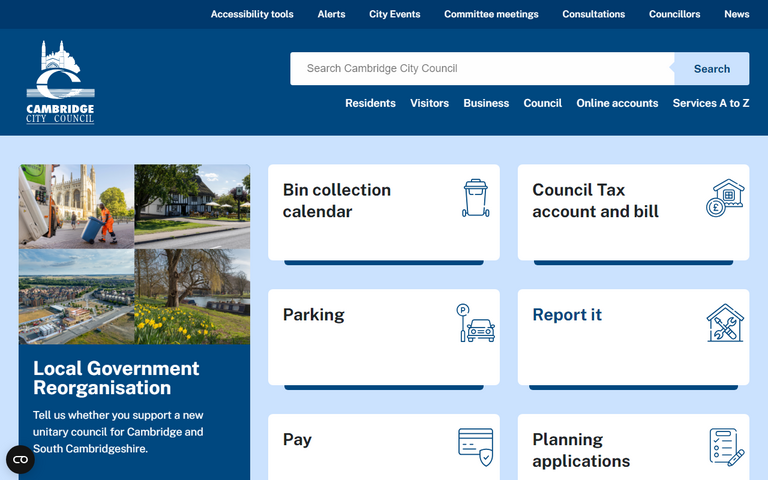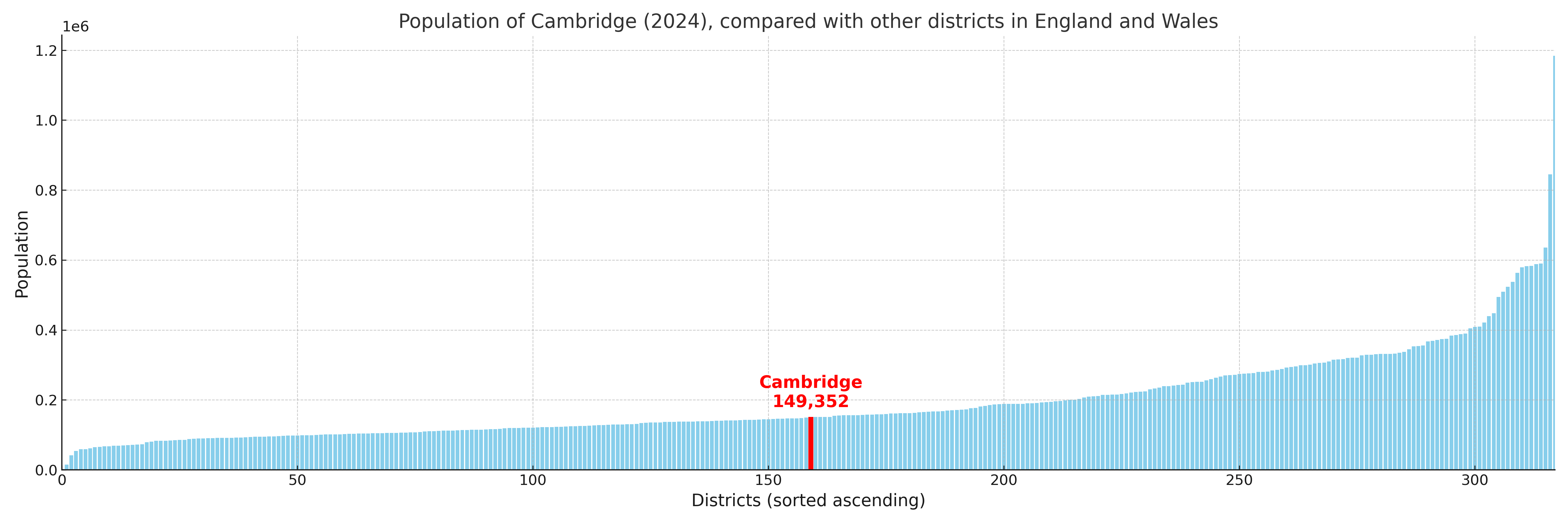Cambridge
§ This page gives an overview of the Cambridge local authority district, bringing together key facts, maps, and data to help you quickly understand the area. One of 361 district profiles on Baseview.
Overview ⁞ Cambridge is a historic city in eastern England, world-renowned for its prestigious university, medieval colleges, and architecture that lines the River Cam, where punting is a popular pastime. The city is compact yet vibrant, blending ancient landmarks such as King’s College Chapel, the Fitzwilliam Museum, and the Round Church with modern science and technology hubs clustered around the Cambridge Biomedical Campus and Silicon Fen. Its green spaces, including Parker’s Piece, Jesus Green, and the Botanic Garden, offer scenic retreats, while the bustling Market Square and winding lanes are filled with shops, cafes, and cultural venues. The city is encircled by charming villages and has a strong cycling culture, with its flat terrain and historic streets making it one of the most bike-friendly cities in the UK.
Cambridge Boundary Map
This map shows the official boundary of the Cambridge local authority district, based on the latest geographic data published by the Office for National Statistics (ONS). It provides a clear view of the district’s extent and helps you understand how the area fits within the wider regional and national landscape.
Contains OS data © Crown copyright and database right 2025. Source: Office for National Statistics licensed under the Open Government Licence v3.0.
The administrative boundary of Cambridge can also be viewed on OpenStreetMap: District Boundary of Cambridge.
Key Facts about Cambridge
What region is Cambridge in? Cambridge is in the East of England of England, a region within the UK.
What county is Cambridge in? Cambridge is located in the county of Cambridgeshire.
Is Cambridge a city? Yes, Cambridge is a city. Cambridge holds official city status as one of the 76 designated cities in the UK.
Who governs Cambridge? The local authority for this district is: Cambridge City Council - responsible for district-level services. Since Cambridgeshire is a two-tier area, county-level services are handled by: Cambridgeshire County Council.
▶ Official website of Cambridge City Council 🔗 cambridge.gov.uk

Which police force covers Cambridge? Policing in Cambridge is provided by Cambridgeshire Constabulary 🔗 cambs.police.uk, which serves 6 local authority districts: Cambridge ⁞ East Cambridgeshire ⁞ Fenland ⁞ Huntingdonshire ⁞ Peterborough ⁞ South Cambridgeshire.
Cambridge in International Geographies
In the International Territorial Levels (ITLs) hierarchy, Cambridge is within one of ITLs Level 2 area, Cambridgeshire and Peterborough, that contains the following 2 ITLs Level 3 areas:
(ITL 1) East of England
(ITL 2) ⇒ Cambridgeshire and Peterborough
(ITL 3) ⇒⇒ Peterborough ⁞ Cambridgeshire CC
The International Territorial Levels are used by OECD member countries for statistical purposes to classify administrative areas. We have this listable page for easy browsing of ITL names and codes: International Territorial Levels.
Constituencies in Cambridge
Cambridge is divided into 2 parliamentary constituencies, listed below in alphabetical order.
A constituency is a specific geographical area that elects one Member of Parliament (MP) to represent them in the House of Commons. The United Kingdom is divided into 650 parliamentary constituencies. We have this list page for easy browsing of all UK parliamentary constituencies: List of Constituencies.
Wards in Cambridge
Cambridge is divided into 14 wards, listed below in alphabetical order.
- Abbey
- Arbury
- Castle
- Cherry Hinton
- Coleridge
- East Chesterton
- King's Hedges
- Market
- Newnham
- Petersfield
- Queen Edith's
- Romsey
- Trumpington
- West Chesterton
In the UK, a ward is a subdivision of a local authority area, used mainly for electoral and statistical purposes. Defined by the ONS, wards represent the primary unit for local elections, each returning one or more councillors to the local council. Wards are also used as a key geography for presenting population and census data.
Parishes in Cambridge
Cambridge is entirely unparished—there are no civil parishes in this local authority district.
Parishes are the lowest tier of local government; where they don’t exist, those very local services and representation sit directly with the principal council.
Built-up Areas in Cambridge
Cambridge covers 2 built-up areas, listed below in alphabetical order.
- Cambridge (Cambridge) *
- Milton (South Cambridgeshire) *
In the UK, a Built-up Area (BUA) is a continuous urban area of at least 20 hectares (0.2 km²), defined by the ONS as land where buildings are generally no more than 200 metres apart, such as towns, cities, or large villages. (Note: A BUA name marked with an asterisk (*) indicates that the area is situated partly in the district of Cambridge.)
Cambridge compared with other districts in the UK
This section shows how Cambridge compares with other local authority districts in the UK, using a variety of measures and rankings.
Cambridge has 14 electoral wards.

Cambridge has a population of 149,352 (2024 mid-year estimate by ONS)

More local statistics and data for Cambridge can be found on the ONS statistics for Cambridge.